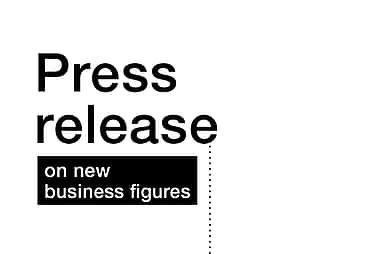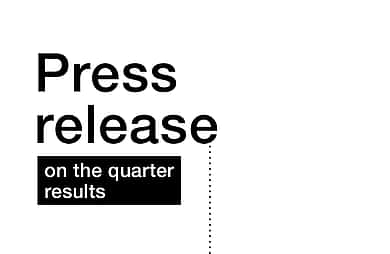- Net interest income increases by 8.8% to EUR 98.0 million (Q2 2019: EUR 90.1 million)
- Settlement of claims and risk provision according to IFRS 9 of EUR 62.2 million (Q1 2020: EUR 50.8 million) as a result of the COVID-19 pandemic
- Net profit amounts to EUR 14.2 million (Q1 2020 EUR 23.7 million)
- First location opens in USA
Baden-Baden, July 30, 2020: grenke AG, a global financing partner for small and medium-sized enterprises, saw the first signs of recovery for its business in the second quarter of 2020. Despite a year-on-year decline in new business at the grenke Consolidated Group of 34.2% in the second quarter of 2020 to EUR 598.1 million (Q2 2019: EUR 909.6 million), new business gained strength towards the end of the second quarter 2020 in June compared to the beginning of the quarter. In terms of income, net interest income rose by 8.8% to EUR 98.0 million.
"We saw a recovery in our new business towards the end of the second quarter. In the beginning of the third quarter, in July, our new business is at roughly 70% of the level in the same month of the prior year, which is higher than in June, when we were at 55%. However, we cannot yet estimate as to whether and how quickly we will continue our upward trend", says Antje Leminsky, Chair of the Board of Directors of grenke AG, in her comments on the business development in the second quarter of 2020 and the further outlook.
The Consolidated Group’s settlement of claims and risk provisions rose again in the second quarter of 2020 and reached EUR 62.2 million (Q1 2020: EUR 50.8 million). This rise stemmed mainly from the leasing business in Italy and France, as these regions with a high share of business were particularly affected by the pandemic. Settlement of claims and risk provisions reduced the net profit in the second quarter of 2020 to EUR 14.2 million (Q1 2020: EUR 23.7 million).
In the first half-year 2020, the settlement of claims and risk provision amounted to EUR 113.0 million (Q1-Q2 2019: EUR 60.7 million). The resulting loss rate for the first half-year 2020 was 2.5%.
"The situation has improved overall. The number of overdue payments in April had doubled, leading to an increase in risk provisions for current contractual relationships. June, and especially July, were significantly better, with a considerable decline in the number of deferral requests. We believe that this also reflects the success of the government’s aid measures. Together with development banks such as KFW, we are making our contribution to securing the business operations of our SME customers right now. We also benefit from the fact that our business model is already established in numerous markets and industries, which results in a high degree of risk diversification. All in all, we expect to see an improvement in the loss rate, and currently anticipate a level of up to 2.3% for the full year, says Sebastian Hirsch, member of the grenke AG Board of Directors, in his comments on the business development in the second quarter of 2020 and further outlook.
First location in the USA
In the second quarter of 2020, grenke opened its first franchise location in the United States (Phoenix, Arizona). As a result, grenke was present in 33 countries with a total of 153 locations as of June 30, 2020.
eSignature still successful
In the second quarter 2020, almost 30% of the contracts were concluded via eSignature. eSignature is established in 20 markets, enabling lease contracts to be processed entirely digitally.
Including the most recent cell divisions and acquisitions, the average number of employees in the grenke Consolidated Group rose by 6.8% to 1,758 compared to the same quarter of the previous year. Staff costs in the second quarter of 2020 amounted to EUR 27.9 million, which was 2.9% lower than in the previous year (Q2 2019: EUR 28.8 million). Selling and administrative expenses decreased by 16.5% to EUR 15.5 million, compared with EUR 18.6 million in the same quarter of the previous year.
The total assets of the grenke Consolidated Group as of June 30, 2020 increased by 7.6 percent to EUR 7.7 billion compared to the end of the 2019 financial year (December 31, 2019: EUR 7.1 billion). This increase resulted primarily from a rise in cash and cash equivalents, which more than doubled to EUR 1.1 billion as of the reporting date (December 31, 2019: EUR 0.4 billion). The higher level of cash and cash equivalents was due mainly to the higher deposit volume at grenke Bank. As of June 30, 2020, the deposit volume incl. the volume of global loans amounted to EUR 1,794 million, representing 29% of the refinancing funds of grenke AG.
With an equity ratio of 16.6%, the Consolidated Group’s balance sheet structure proved to be solid, remaining above the long-term benchmark of 16.0%.
Outlook for 2020
The scope and extent of the impact of the COVID-19 pandemic on the grenke Group’s further business and earnings development cannot yet be assessed with any certainty and has not been included in the forecast for the 2020 financial year published on February 11, 2020. In light of the general economic restrictions resulting from the COVID-19 pandemic, the Board of Directors is currently assuming that the level of new business leasing in the third quarter of 2020 will amount to roughly 70% of the prior-year level. Consequently, new business development for the current financial year as a whole remains dependent on the further course of the COVID-19 pandemic. At the beginning of the year, the initial target for new business leasing growth was between 14 and 18%.
The Consolidated Group can operate profitably during this crisis with a lower volume of new business and the appropriate cost savings; net profit however will be below the target range of EUR 153 to 165 million announced at the beginning of the year. Based on the solid liquidity situation and the stable number of employees – especially in sales – the grenke Consolidated Group is in a position to respond immediately to any respective easing or normalisation developments.
The Board of Directors will update its forecast as soon as the impact of the COVID-19 pandemic can be sufficiently determined.


